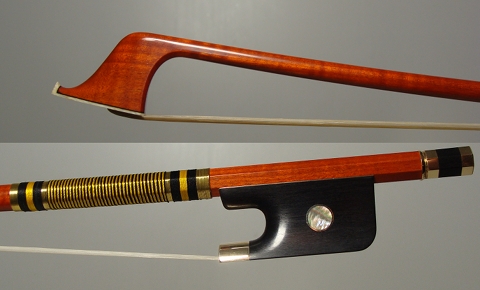CLOSE ENCOUNTERS OF THE THIRD KIND- is one of the reasons I do this job. I have chosen to open a workshop, with all the problems that this entails. I could have chosen to sell French bows of average standard, and certainly with a more relaxed lifestyle. I would then have missed experiences like the one we had this weekend. A meeting between an exceptional musician, a great craftsman and the surreal encounter of instruments. Master Antonio Meneses and my colleague, Master Navea Vera An excellent musician, with a beautiful Alessandro Gagliano cello, a D.T. Navea Vera bow, and for once the craftsman, who supervises the result of his work. To attend such meetings make you think about the concept of life itself and how we understand it. The same thing happened between these two gentlemen. Even though they didn't have a common language, they understood each other perfectly, so much so that the Master, spent his time, in between rehearsals, in our workshop watching my colleague work. Among living beings, although not very often, these things happen. Kindred spirits, we could call them. It is less likely though, that these things happen to machines. I have used the word machine, and I admit that is a bit simplistic, but in part they are, though with the addition of something I think no one has ever been able to explain completely. To see a centuries-old instrument, which interacts and changes, communicating with a bow finished only the day before, is something that I have not managed to explain, at least with reason. It is not a simple change of tone or volume, but a process of self-alignment between the two objects. As if they discuss and within a few minutes agree on a common course. What's even more surprising, is what happens when you switch bows. For a few minutes, the instrument continues to maintain the sound characteristics it produced with the other bow. It can be difficult to believe if you have never witnessed this phenomenon, and for this reason I asked Master Meneses', permission to film it. Cello bow "Daniel" - D. T. Navea Vera - competition Etienne Vatelot - Paris 2011 Besides Maestro Meneses, and his beautiful Gagliano cello, the co-protagonist is the bow that my colleague, presented at the competition Etienne Vatelot 2011. On my way back to Italy, after the competition, I decided to go visit the Master. In this part of the video, the test session has just begun, and the instrument, which has a very strong character, doesn't respond immediately to the stimuli of this beauty, and almost seems to complain. Master Antonio Meneses, using "Daniel" on his cello (Part One) Being accustomed to the bow of the Master, the cello, continue to have a sweet, but less tense imprint. It takes a bit before the instrument understands the newcomer, but note after note, the sound acquires volume, dynamic and three-dimensionality. However, if you pay attention to the sound of the instrument played with the D.T. Navea bow, in the beginning of the next video, you will hear that the sound seems more like the last 30 sec. of the previous video. This happens because the instrument, which is subjected to a different and very intense stimulus, at least for some time, maintains part of the sound characteristics of the object that has stimulated it. Master Meneses, using "Daniel" on his cello (Part Two) This phenomenon happens in the workshop as well. A customer who tries a bow of Master Navea Vera, will find that the sound improves. Then, with the instrument tuned into this bow, the sound remains unchanged when he plays with his own bow. Therefore it may seem to him that his bow isn't too bad after all, and leaves convinced that this is the case. However, the beneficial effect is far from permanent and he will soon find that the instrument plays like it as it always has. I thank Master Meneses, for the beautiful concert he held, as well as the opportunity to show these videos, and of course, for the time spent together talking about music and bows. So long, Paolo.
|
   |






